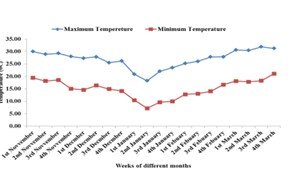Agro-morphological characterization of flax (Linum usitatissimum L.) accessions at north-western part of Bangladesh
Abstract
Flax (Linum usitatissimum L.), grown throughout the world for millennia. It is a multipurpose agricultural crop that can provide food, fuel and fibre. An agro-morphological characterization based on 13 traits of 26 flax accessions was carried out during the Rabi season 2017-2018 at the Agricultural Research Station, Bangladesh Agricultural Research Institute, Rangpur. The field experiment was laid out in a randomized completed block design having four replications. Flax seeds were sown in 3.0 m × 0.6 m plot with continuous line sowing (two lines). The seed germination (%) and vigour indices of all flax accessions varied from 44.1 – 77.7 and 44.1 – 119.4, respectively. A significant variation in all growth and yield attributing descriptors was observed except 1000-seed weight of flax. Among the accessions, BD-10708 possessed the highest seed yield (182.9 g plant–1) and yield attributing descriptors viz., number of capsules plant–1 (142) and seeds plant–1 (513) of flax. The performance of the local accesson Ulipur was observed poor compared to some of the test accessions of flax. Some of these flax accessions could be used as breeding materials in varietal developmental and improvement programmes with higher yield potentials of flax in Bangladesh.
Keywords:
Flaxseed, Growth, Morphological descriptors, Yield attributesDownloads
References
Badwal, S.S., Gill, K.S. and Singh, H. (1971). Correlation and regression studies in linseed. Indian Journal of Agricultural Sciences, 41: 475-478.
BARC (Bangladesh Agricultural Research Council) (2012). Fertilizer Recommendation Guide. Farm Gate, Dhaka, Bangladesh.
BBS (Bangladesh Bureau of Statistics) (2019). Statistical Year Book Bangladesh 2018. 38th ed., Statistics and Informatics Division, Ministry of Planning, Government of the People's Republic of Bangladesh, Dhaka, Bangladesh. pp. 148 -302.
Bewley, J.D. and Black M. (1994). Seeds Physiology of Development and Germination. Plenum Press. USA.
Deyholos, M.K. (2006). Bast fiber of flax (Linum usitatissimum L.): Biological foundations of its ancient and modern uses. Israel Journal of Plant Sciences, 54, 273-280, https://doi.org/10.1560/IJPS_54_4_273
Dhirhi, N., Shukla, R., Patel, N.B., Sahu, H. and Mehta, N. (2015). Extraction method of flax fibre and its uses. Plant Archives, 15: 711-716.
Fila, G., Bagatta, M., Maestrini, C., Potenza, E. and Matteo, R. (2018). Linseed as a dual-purpose crop: evaluation of cultivar suitability and analysis of yield determinants. The Journal of Agricultural Science, 156: 162-176, https://doi.org/10.1017/S0021859618000114
Goudenhooft, C., Bourmaud, A. and Baley, C. (2017). Varietal selection of flax over time: evolution of plant architecture related to influence on the mechanical properties of fibers. Industrial Crops Production, 97: 56-64, https://doi.org/10.1016/j.indcrop.2016.11.062
Goudenhooft, C., Bourmaud, A., & Baley, C. (2019). Flax (Linum usitatissimum L.) fibers for composite reinforcement: exploring the link between plant growth, cell walls development, and fiber properties. Frontiers in Plant Science, 10, 411.
Guo, D., Jiang, H., Yan, W., Yang, L., Ye, J., Wang, Y., Yan, Q., Chen, J., Gao, Y., Duan, L., Liu, H. and Xie, L. (2020). Resequencing 200 flax cultivated accessions identifies candidate genes related to seed size and weight and reveals signatures of artificial selection. Frontiers in Plant Science, 10: 1682, https://doi.org/10.3389/fpls.2019.01682
Hamilton, I. (1986). Linen. Textiles, 15: 30-34.
Kurt, O. (2010). Effects of chilling on germination in flax (L. usitatissimum L.). Turkish Journal of Field Crops, 15: 159-163.
Mezghani, N., Zaouali, I., Amri, W.B., Rouz, S., Simon, P.W., Hannachi, C., Ghrabi, Z., Neffati, M., Bouzbida, B. and Spooner, D.M. (2014). Fruit morphological descriptors as a tool for discrimination of Daucus L. germplasm. Genetic Resources and Crop Evolution, 61: 499–510, https://doi.org/10.1007/s10722-013-0053-6
Mohammed, A.R., Holgate, L.C. and Tarpley, L. 2017. Characterization of northern spring flax as a winter Crop for southeast Texas. Journal of Agricultural Science, 9: 8, https://doi.org/10.5539/jas.v9n8p1
Nordqvist, J. (2016). Flaxseed: Health Benefits, Facts, Research. http://www.medicalnewstoday.com/ articles/263405.php
Nôžková, J., Pavelek, M., Bjelková, M., Brutch, N., Tejklová, E., Porokhovinova, E. and Brindza, J. (2016). Descriptor list for Flax (Linum usitatissimum L.). Slovak University of Agriculture in Nitra, Slovakia.
Patial, R., Paul, S., Sharma, D., Sood, V.K. and Kumar, N. 2019. Morphological characterization and genetic diversity of linseed (Linum usitatissimum L.). Journal of Oilseeds Research, 36: 8-16.
Savita, S.G., Kenchanagoudar, P.V., Parameshwarappa, K.G. and Rudranaik, V. (2011). Correlation and path coefficient analysis for yield and yield components in linseed (Linum usitatissimum L.) germplasm. Karnataka Journal of Agricultural Sciences, 24: 382-386.
Sharma, H. and Van Sumere, C. (1992). Enzyme treatment of flax. Genetic Engineering and Biotechnology, 12: 19-23.
Shreelalitha, S.J., Sridhar, K.R. and Sukesh, S. (2015). Seed dormancy and germination in two wild genotypes of Sesbania of the Southwest mangroves in India. International Journal of Agricultural Technology, 11: 895-902.
Van Sumere, C. (1992). Retting of flax with special reference to enzyme-retting. In: Sharma, H. and Van Sumere, C. (eds.), The Biology and Processing of Flax. M Publications, Belfast, Northern Ireland. p. 157-198.
Worku, N., Heslop-Harrison, J.S. and Adugna, W. (2015). Diversity in 198 Ethiopian linseed (Linum usitatissimum) accessions based on morphological characterization and seed oil characteristics. Genetic Resources and Crop Evolution, 62: 1037–1053. https://doi.org/10.1007/s10722-014-0207-1
You, F.M., Cloutier, S., Rashid, K.Y. and Duguid, S.D. (2019). Flax (Linum usitatissimum L.) Genomics and Breeding. In: Al-Khayri, J., Jain, S. and Johnson, D. (eds) Advances in Plant Breeding Strategies: Industrial and Food Crops. Springer, Cham. https://doi.org/10.1007/978-3-030-23265-8_9

Published
How to Cite
Issue
Section
Copyright (c) 2020 Agriculture and Environmental Science Academy

This work is licensed under a Creative Commons Attribution-NonCommercial 4.0 International License.

